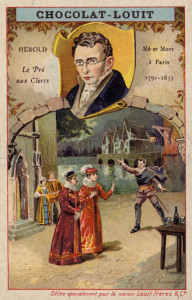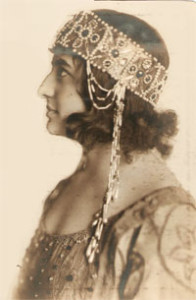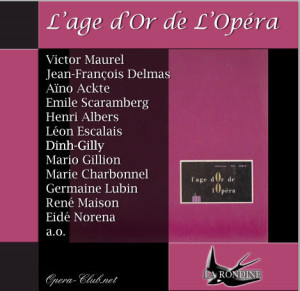Voran gestellt: Die Firma opera-club.net gibt es nicht mehr, mit dem Tod deren Gründers und In Inhabers Walter Knoeff (s. dessen Nachruf hier bei operalounmge.de) ist auch vieles aus dem Repertoire dieses einzigartigen Live-Labels verschwunden, und es gibt kaum Hoffnung auf Wiederbelebung. Dennoch: Wegen des Informationswertes lassen wir diesen Artikel bei uns stehen.
Berühmte Namen des französischen Gesangs aus Zeit vor dem und nach den beiden letzten Kriegen finden sich auf jeweils 3 CDs der Ausgaben L’âge d’Or de L’Opéra Comique und L’âge d’Or de L’Opéra auf dem Label Rondine bei opera-club.net. Namen, die die Kenner in Verzückung bringen und Sänger, an denen kein Opernliebhaber vorbei kommt, der Heutiges beurteilen will. Gerade die französische Oper erholt sich ja nur ganz langsam von dem Kahlschlag des Krieges und der sechziger Jahre, als Internationalismus die Einheimischen erst in die Provinz und dann ins Vergessen drängte. Namen wie César Vézzani, Ninon Vallin, David Dévries, Emma Luart, Robert Massard und viele andere sind heute unbekannt, nur Altere erinnern sich und rollen mit den Augen. Hier nun die große Chance, in einer beispielhaften Anthologie „Le Grand Repertoire“ und bezaubernden Opéra Comiques zu erleben, meisterhaft vorgetragen. Im Folgenden wieder der Text von opera-club.net. G. H.

Hérold: Schokoladen-Beilage-Bildchen für „Les Prés aux Clercs“/OBA
French Opera is one of Europe’s most important operatic traditions, containing works by composers of the stature of Lully, Rameau, Berlioz, Bizet, Debussy, Poulenc and Messiaen. Many foreign-born composers have played a part in the French tradition as well, including Gluck, Salieri, Cherubini, Rossini, Meyerbeer, Offenbach and Verdi. French opera began at the court of Louis XIV of France with Jean-Baptiste Lully’s Cadmus et Hermione (1673), although there had been various experiments with the form before that, most notably Pomone by Robert Cambert. Lully and his librettist Quinault created tragédie en musique, a form in which dance music and choral writing were particularly prominent. Lully’s most important successor was Rameau. After Rameau’s death, the German Gluck was persuaded to produce six operas for the Parisian stage in the 1770s. They show the influence of Rameau, but simplified and with greater focus on the drama. At the same time, by the middle of the 18th century another genre was gaining popularity in France: opéra comique, in which arias alternated with spoken dialogue. By the 1820s, Gluckian influence in France had given way to a taste for the operas of Rossini. Rossini’s Guillaume Tell helped found the new genre of Grand opera, a form whose most famous exponent was Giacomo Meyerbeer. Lighter opéra comique also enjoyed tremendous success in the hands of Boïeldieu, Auber and others. In this climate, the operas of the French-born composer Hector Berlioz struggled to gain a hearing. Berlioz’s epic masterpiece Les Troyens, the culmination of the Gluckian tradition, was not given a full performance for almost a hundred years after it was written.

„La Nave“: Rosa Raisa im Kostüm der Basilola Chicago 1919/Grattacielo
In the second half of the 19th century, Jacques Offenbach dominated the new genre of operetta with witty and cynical works such as Orphée aux enfers; Charles Gounod scored a massive success with Faust; and Bizet composed Carmen, probably the most famous French opera of all. At the same time, the influence of Richard Wagner was felt as a challenge to the French tradition. Perhaps the most interesting response to Wagnerian influence was Claude Debussy’s unique operatic masterpiece Pelléas et Mélisande (1902). Other notable 20th century names include Ravel, Poulenc and Messiaen. From the moment music could be recorded the French have presented their operas and singers on role and disk. People claim it’s the largest historical catalogue in this category.
For years this was hardly noticed, in spite of the fact that during the vinyl-episode sometimes very interesting French compilation albums appeared on the market that outside of France hardly got the right attention from the music critics and audiences.
The problem was probably that all attention went to singers like Enrico Caruso, Nelly Melba, Mattia Batistini, Ezio Pinza, etc., no matter what they were singing, but generally in Italian. International singers would sing Carmen, Faust, Romeo et Juliette, Manon etc., but the more idiomatic French singers like Cesar Vezzani and Georges Thill, Emma Calvé, Ninon Vallin, a.o. , were only appreciated outside the French-language area by a small club of connoisseurs and fans of the French repertoire, in spite of the fact that they often were better musicians and stylistic more in control of the French idiom. Labels like Malibran nowadays make a new effort to get the focus on the French singers as well as on the less known operas, which is not an easy task.
We also make an attempt and in case you’re a real voice lover and looking for adventure in operas instead of listening to Carmen No. …, this is the ideal opportunity. Restored with the latest technical possibilities, without losing its authentic sound and characteristics.
The Théâtre national de l’Opéra-Comique, also known as Salle Favart is a theater in Paris. The present building at the Rue Favart dates from 1898, two earlier buildings on the same location burned down in 1838 and 1887. The Opéra-Comique was founded in 1714 to offer a French alternative for the in those days dominant Italian opera. At first it mainly presented pantomime and parodies on operas. It later developed the genre opera comique, distinguishing itself from the classical opera by a less formal setting and the alternation between sung and spoken dialogues, that however wasn’t necessarily comical in nature, especially in the 19th century. The concept wasn’t immediately successful, which made the theater close from 1719 till 1720 and from 1722 till 1723. In 1743 Jean Monnet took charge of the Opéra-Comique and he hired the writer Charles-Simon Favart. From 1745 till 1751 the theater was closed again. After the fusion in 1762 with the Comédie-Italienne a new theater was opened at the Rue Favart, on the location of the present building.
During the French Revolution the Opéra-Comique remained open, but the competition of theThéâtre Feydeau was killing. In 1801 the two companies fused into the Théâtre national de l’Opéra-Comique. In the 19th century the theater flourished, mainly because of compositions from Adolphe Adam, Daniel Auber, Georges Bizet, Nicolas Bochsa and Jules Massenet. Bizets famous opera Carmen had its première there (1875), like La damnation de Faust van Hector Berlioz (1846) and Claude Debussy’s Pelléas et Mélisande (1902). In the 1930’s the government had to take steps because of the financial problem of the theater. In 1936 the Opéra-Comique and the Opéra de Paris ) together formed the Réunion des Théâtres lyriques nationaux (RTLN). On November 30th, 1972 the Opéra-Comique ceases to exist. In 1974 the Salle Favart is namedOpéra-Studio and will be serving as acting school. In 1978 the Opéra-Studio closes its doors and the theater will be run by the Théâtre national de l’Opéra. In 1990 the Opéra-Comique restarts its activities as an independent organization. Right after the re-opening of the theater it was mainly used for incidental performances and had a limited agenda. The Opéra-Comique was aiming for both musictheatre and non-musical productions. Musically the emphasis lies with the baroque until contemporary music. In 2000 Jérôme Savary became artistic director of the theater.
His goal was to transform the theater into a theater for “classical amusement”. The repertory became a variety of both the original opéra comique and operettas, musicals and revue. Jérôme Deschamps became Savary’s successor by the end of 2007.
 The Palais Garnier is an opera building in the French capital Paris, built between 1861 and 1875. It was designed by architect Charles Garnier, as an assignment of Napoleon III. The building was supposed to open in 1871, but dur to the French-German War the opening was delayed until January 5th, 1875. The interior is richly decorated with gold foil, fresco’s and marble. The ceiling was painted in 1964 by Marc Chagall. The style is called neo-baroque, eclectic and extravagant. The building has its fame for a.o. performances like The Ghost of the Opera, a novel by Gaston Leroux. The ghost would have been responsible for numerous conflicts and crimes. Rumours were that a peculiar deformed creature was haunting in the underground corridors of the opera. These days mainly ballet performances are scheduled; the function of the opera has for a great part been taken over by Opéra Bastille. It is the largest opera building in the World, with a surface of over 11.000 m2. The building is 125 meters wide, 173 meters long and 73,6 meter high. The operaroom holds 2131 spectatots and the scene, about 1200 m2, can hold 450 artists. The chandelier in de central hall weighs 6000 kg and was designed by Garnier himself. The luxurious has a grand foyer, a staircase of different kinds of marble, an arch decorated by Isidore Pils and a ceiling painted with a kind of Olympus by Marc Chagall in 1964, honoring 14 ballet and music composers with their respective works.
The Palais Garnier is an opera building in the French capital Paris, built between 1861 and 1875. It was designed by architect Charles Garnier, as an assignment of Napoleon III. The building was supposed to open in 1871, but dur to the French-German War the opening was delayed until January 5th, 1875. The interior is richly decorated with gold foil, fresco’s and marble. The ceiling was painted in 1964 by Marc Chagall. The style is called neo-baroque, eclectic and extravagant. The building has its fame for a.o. performances like The Ghost of the Opera, a novel by Gaston Leroux. The ghost would have been responsible for numerous conflicts and crimes. Rumours were that a peculiar deformed creature was haunting in the underground corridors of the opera. These days mainly ballet performances are scheduled; the function of the opera has for a great part been taken over by Opéra Bastille. It is the largest opera building in the World, with a surface of over 11.000 m2. The building is 125 meters wide, 173 meters long and 73,6 meter high. The operaroom holds 2131 spectatots and the scene, about 1200 m2, can hold 450 artists. The chandelier in de central hall weighs 6000 kg and was designed by Garnier himself. The luxurious has a grand foyer, a staircase of different kinds of marble, an arch decorated by Isidore Pils and a ceiling painted with a kind of Olympus by Marc Chagall in 1964, honoring 14 ballet and music composers with their respective works.

Unvergessen: Sammler und Live-.Pionier Walter Knoeff/ OBA
Fortunately the French discovered in an early stage how to preserve their singer for eternity. Yet they didn’t get the attention they deserved and couldn’t surpass singers like Caruso, Melba, Ponselle, Martinelli, etc.. The same was the case with composers like Verdi, Wagner, Puccini and others. The only French opera holding a first place was Carmen of Georges Bizet. There’s still a lot to discover in the French repertoire as well as with the interpreters. The second L’âge d’Or collections are a treasure for voice collectors and fans who like to hear something different than the standard repertoire. (3 CD; RO-1024: L’âge d’Or de L’Opera Comique; 3 CD; RO-1025: L’âge d’Or de L’Opera). Opera-club.net
Und dann noch: Around 1970 RCA-Italy released a 14-pieces album series named “L’Epoca d’Oro del Melodramma” It became known in the USA around 1900 that sound recordings could be made and saved, and RCA immediately took the initiative to contract famous opera singers, especially known in North-America, to make sure their voices would be conserved for eternity – an initiative for which we will be eternally grateful. Recordings of a.o. Enrico Caruso, Nelly Melba and John McCormack became hits. Many collectors didn’t rest until they had a complete collection of these singers. Fanclubs of listeners were founded and a vivid trade and exchange of vinyl albums started. The release of the albums caused a lot of anxiety among the vinyl-fans. Press and audience attacked RCA because the opinion was that they were tampering with the recording.
However, one forgot that RCA owned the original recordings and could use the vinyl to avoid noise and all disturbances. Not just RCA, but also HMV and other small companies were criticized, and not always unrightfully so. There was a lot of experimenting to record the sound as authentic as possible on the vinyl, inclusive the dropping of the needle and all damages. Microphones were hung before the pathephone horns to catch the sound, and eventually RCA, among a few others, became the winner. Over the last years few historical recording have been released on CD, and it’s really the French label Malibran and the American Marston Records that are still releasing historical material. “L’Epoca d’Oro del Melodramma” has never been released on CD, which gave us the opportunity to present to you, thanks to the latest restoration equipment, the best recording for now. You will be surprised about the results. RO-1027: L’Epoca d’Oro del Melodramma This is the famous 14-piece record series of RCA that peculiarly never has been released on CD. It focuses on singers that were popular in America and had the status of pop stars, especially in the early 20th century. Many of these recordings have been released on well-known, but also obscure labels, which didn’t do the sound quality any good – another reason to add this series to your collection.W. K.

